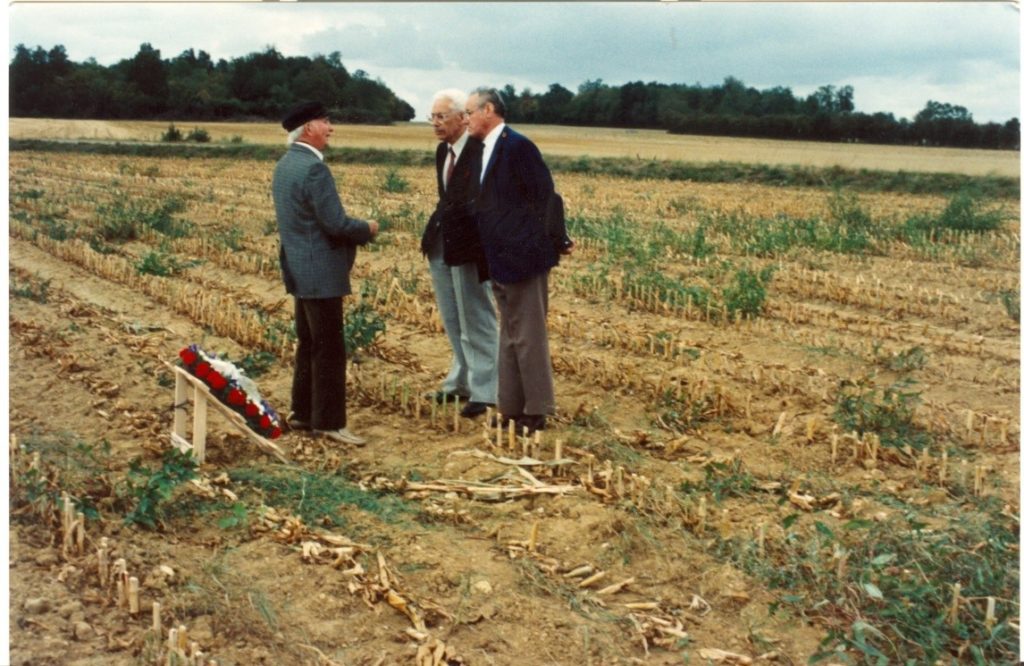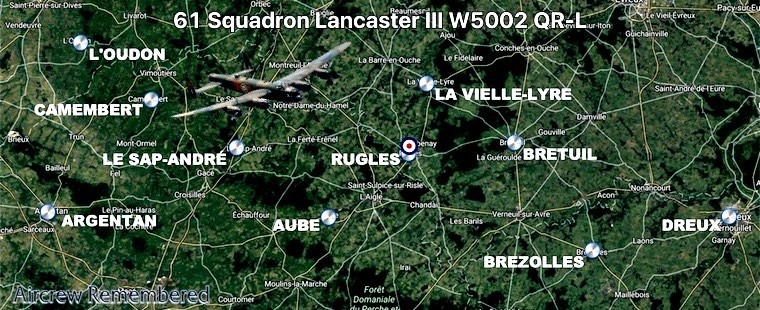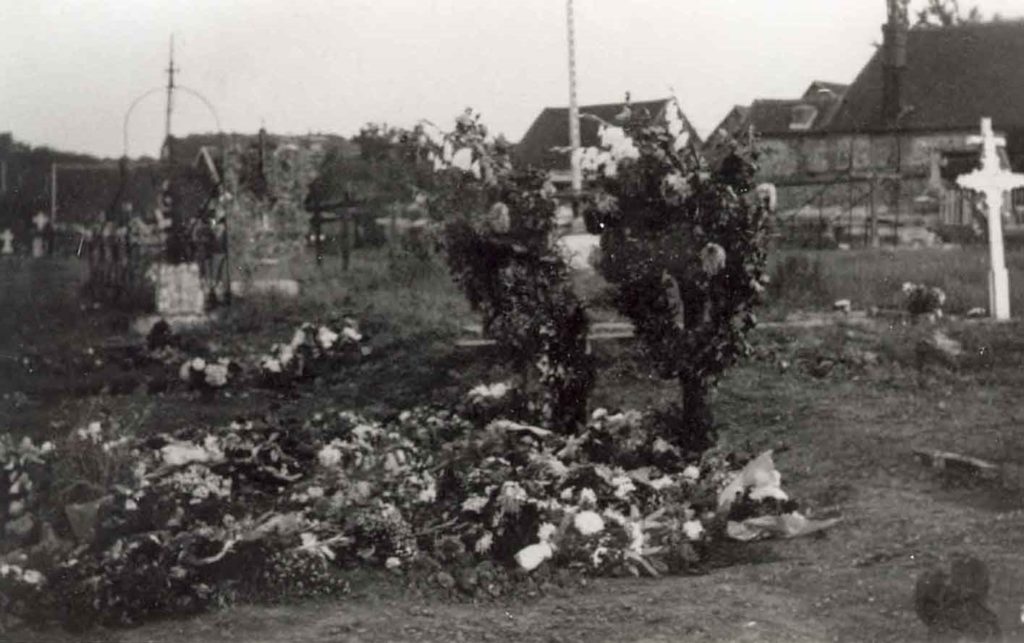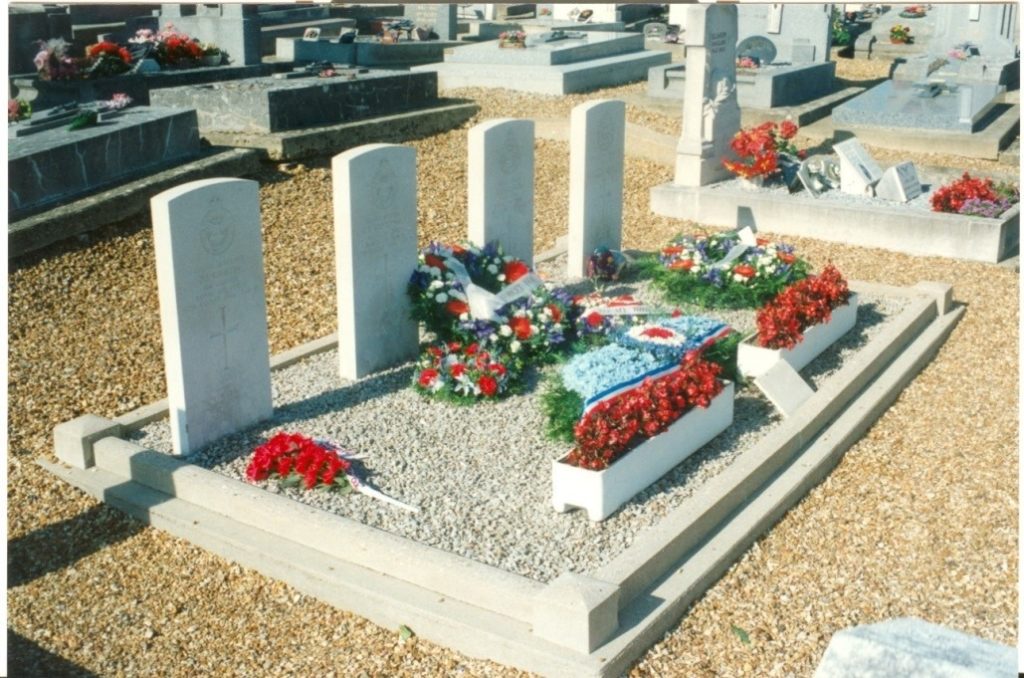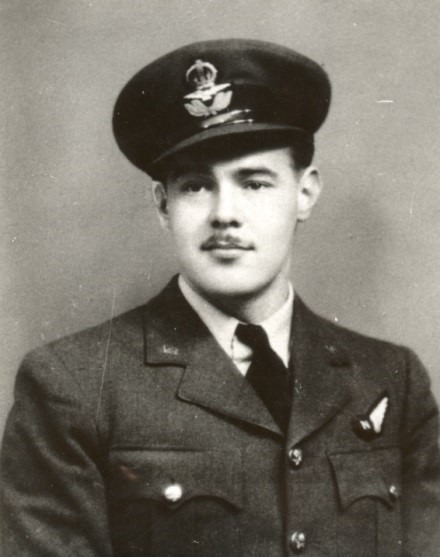
F/O Tom Downing RAFVR
Operation: Milan
Date: 15/16th August 1943 (Sunday/Monday)
Unit: No. 61 Squadron
Type: Lancaster III
Serial: W5002
Code: QR-L
Base: RAF Syerston
Location: Rugles, France
The Crew of W5002 QR-L:
Pilot: Sgt. P. Victor Matthews 658607 RAFVR Evaded (see note 1) Victor Matthews passed away 22nd March2017
Fl/Eng: Sgt. Kenneth Thomas Brentnall 1477508 RAFVR Age 21. Killed
Nav: F/O. Tom Downing 131604 RAFVR Age 21. Missing – believed killed
Air/Bmr: P/O. Conrad Larnach 149693 RAFVR Age 22. Killed
W/Op/Air/Gnr: Sgt. Gordon Arthur Angwin 1386110 RAFVR Age 21. Missing – believed killed
Air/Gnr: Fl/Sgt. John Edward Walden AUS/425386 RAAF Age 27. Killed
Air/Gnr: Sgt. James John Griffin 1153700 RAFVR Age 23. Killed
The Crew from left to right: Sgt. John Waldren, Sgt. Gordon Angwin, Sgt Vic Matthews, Sgt. James Griffin, Sgt. Conrad Larnach and Sgt. Kenneth Brentnall
Introduction
This is a record of the loss in action of my late uncle, Flying Officer Tom Downing, RAFVR. The actual circumstances of his loss were always something of a mystery and a source of great wonderment for me as I grew up in post-war Hull. Although I was born eight months after he was reported missing, some of my earliest memories are of a loving family desperate to believe he might somehow return one day, there being not the slightest trace of his passing. I have shared in these thoughts and feelings, with an enigmatic affinity that has remained with me over the years, though this has faded with time. As there were no remains or identification ever found for Tom Downing or Sgt. Gordon Angwin, they are simply commemorated on the Royal Air Force Memorial, Runnymede. I was taken on a to visit to the new Memorial by my maternal Grandparents when I was eight years old, and this certainly has had a profound and lasting effect on me.
My father Herbert served as a Corporal with the RAF Police during the war. After the pilot’s safe return to the UK in November 1943, my father had somehow managed to contact him. They had a brief meeting, but the pilot was unable to provide any further information at the time, other than that which he had officially reported. He told of how he had been rendered unconscious on baling-out of the burning aircraft, and had no knowledge of his crew’s fate.My Grandmother Eliza, was heartbroken. She never seemed to recover from the loss of their youngest son, and she died in 1949. From as young as I can remember, until about ten years old, I spent almost every weekend with my Grandparents. I slept in Tom’s old room, with many little reminders of him; photographs and books, even one or two of his old toys remained in the cupboard over the stairs. I treasured these, especially a delicate silk-covered model aircraft, which I was allowed to handle, with the greatest care.
In 1986, I wrote to the RAF, Air Historical Branch 5, at the Ministry of Defence, to inquire if there were any RAF records, which might provide some information as to what had happened more than forty years earlier. I received a very polite reply confirming the identities of the aircrew, the location of the crash site and the aircraft number, W5002, coded QR-L with 61 Squadron, RAF. Further enquiries resulted in correspondence with RAF Air Historical Branch 3, which erroneously listed Tom as the Bomb Aimer. (This was later corrected). They confirmed the location of the graves of the four crew buried at Rugles, France. I was advised to contact RAF Personnel Management Centre at Gloucester for any further information and for a copy of Tom’s Service Record.
Whilst awaiting a reply from Gloucester, my Mother-in-law told me of a letter published in the Hull Daily Mail dated 27 September 1990, from a Monsieur Albert Lecocq of Rugles, France, and she sent me a cutting. The compilation of these records and communications are a direct result of that chance letter reaching me, 200miles away, in Berwick upon Tweed. In April 1991, I had the privilege to meet Victor Matthews, the pilot. He and his wife Rosemary visited us in Berwick, following further correspondence with Albert Lecocq. Later that year, my wife Pat and I accompanied them to Rugles, for a formal reception by the civic authority with other relatives of the crew, and to place an engraved plaque at the crew graves. It was a very poignant and moving time for all concerned. We were presented, in Tom’s name, with a posthumous Médaille de la Ville de Rugles and an illuminated Certification. I felt privileged to have had the chance to visit the site of the crash, and to talk with the local people, who had not only witnessed the events of August 1943, but had survived to tell others.
At the crash site Raymond Lavier talks with Vic Matthews (right) and Albert Lecocq 1991.
Recently, my researches concluded with the confirmation of the loss of Lancaster W5002 (QR-L) as being credited to Leutnant Detlef Grössfuss DKG, (see note 3), of Luftwaffe 2/JG2 Richthofen Geschwader. He was later wounded in action, on 5th July 1944, but survived the war, as Oberleutnant, leading 9/JG2. He is credited with 30 victories, and was awarded the DKG (German Cross, in Gold), the Ehrenpokal Goblet and Iron Cross First Class. Originally, my intention was simply to arrange this information into an appropriate format, which could be retained within the family. I now feel satisfied that I have been able to eliminate any doubts concerning my Uncle Tom’s loss, and I have prepared the following narrative, drawing directly on the official records and my experiences in France. The records and transcripts are appended.
F/O Tom Downing RAFVR:
Tom was born in Hull, East Yorkshire, on 19th October 1921, the youngest son of Herbert and Eliza Downing, and younger brother to my father, Herbert. There had been three earlier children, but they had all died in infancy. He was always known as Tommy, and was educated at Malet Lambert High School, having attained a scholarship there, and entered the Police Service as a cadet in 1940.
After attending No.5 Aircrew Selection Board, he was recommended for training as Observer/Pilot and he joined the Royal Air Force on 20th July 1941, aged 18. Tommy reported to No.1 Aircrew Reception Centre on 27th October for initial kitting, preliminary drill instruction and his introduction to service life. Posting to No.1 ITW (Initial Training Wing) followed on 29th November, for basic flying theory, service protocol, etc.
Promoted to LAC on 23rd January 1942, he continued to No.1 (EAOS) (Elementary Air Observer School) on 14th February. On 17th May he embarked for Canada, to join No.32 Advanced Navigation School at RAF Charlottetown, where he qualified as an Observer/Navigator. (Until 1942, observer training, comprised of the four disciplines of navigation, wireless, gunnery and bomb aiming. After 1942, training was confined to the individual ‘trades’.) This advanced course earned him the qualification of the coveted “Flying O” brevet, and an appointment to a commission in the rank of Flying Officer, effective from 24th September 1942, as a Navigator. Then it was on to No.33 Advanced Navigation School, followed by parachute training, finally returning to No.4 Air Observer School before embarking for the UK to arrive at No.19 Operational Training Unit, RAF Kinloss. Posting to No.1661 HCU (Lancaster Heavy Conversion Unit) at RAF Winthorpe, Lincolnshire (A satellite of RAF Swinderby) followed on 12th May 1943. It was at this stage of training that the process of ‘crewing-up’ would start. A given number of individual trades would be assembled in a hanger to voluntarily form up into a specific number of crews. On completion of this course, Tom was posted to No.61 Squadron at RAF Syerston, Nottinghamshire, to commence operational flying on 24th June 1943. It was the culmination of almost two years intensive training.
The records show the other members of the crew, (all NCO’s), were also posted in to 61Squadron on 24th June 1943 from 1661 HCU, and presumably the seven had formed up as a crew there, prior to their first operational posting. Sgt Matthews first flew as U/T pilot (under training) with Plt.Off. W.C. Parsons as Captain (pilot in command) to Gelsenkirchen on 25/26 June. On 28/29 June he had his own command for a raid on Cologne, with his new crew and Sgt.Dudley as navigator. On 1/2 July, the same crew flew a minelaying operation, but with F/O. H.L. Hewitt as navigator. Two nights later, on 3/4 July, a further raid on Cologne, but again with a different navigator, Sgt. S.G. Palk. (see note 2) After a short break of four days, on 8/9 July an operation (unspecified) with yet another navigator, Sgt.J.K.Forrest. The next night, 9/10 July, saw a return to Gelsenkirchen, again with yet another navigator, Sgt. L.R. Lovett.
For the first time operationally, on 2/3 August, the ‘full crew’ of Sgt Matthews (captain and pilot), Sgt. Brentnall (flight engineer), Sgt. Larnach (bomb aimer), Sgt. Angwin (WT/ air gunner), Sgt. Waldren (air gunner), Sgt. Griffin (air gunner) and Tom as navigator, flew on an operation to Mannheim in Lancaster W5002 (Q-RL). The next night (10/11 August) they again flew together, in the same aircraft, raiding Nurnberg. A one-day break, then on 12/13 August, (again in what they then considered to be ‘their’ aircraft, now named ‘London Pride’), for the long haul of eight and a half hours to Milan and back. The reason for Tom not being with other members of the crew for their first five trips together is not known.
On the night of 15/16 August, the crew were briefed for a repeat raid on Milan, flying exactly the same route, Syerston – Selsey Bill – Cabourg – Lac du Bourget – Milan. The bomb load comprised of 1 x 4000lb ‘Cookie’, 3 x 150 x 4lb Incendiary bombs and 2 x 16 x 30lb incendiaries. The Lancaster BIII took off from Syerston at about 2230 hours in good weather and a full moon. Course was set at 2300 hours and the Pilot climbed on track to the English coast. The French coast was crossed at 16,500 ft., at Caen, dead on track and time. Just after crossing the coast the Rear Gunner reported an unidentified aircraft on the starboard quarter. The Pilot executed a steep diving turn to starboard and the aircraft passed to port and was identified as a Beaufighter. During this incident Monica, set to give warning at 600 yards, functioned perfectly. The pips increasing in speed as the fighter approached and decreasing in speed as she overtook. The Rear Gunner remarked on the excellence of the device.Sgt. Matthews turned back on to course and two or three minutes later, without any warning from Monica or either Gunner, the Lancaster was attacked by a fighter with cannon and machine gun fire. The attack appeared to come from astern and red flashes, which may have been tracer, filled the cockpit. There was a tearing sound in the fuselage, the whole aircraft vibrated violently and Sgt. Matthews could hear shells impacting and exploding behind him. He immediately executed a very steep diving turn to starboard. Three or four seconds later a wall of red flame shot up from the vicinity of the forward escape hatch and enveloped the Pilot and the Flight Engineer who was sitting beside him. Sgt. Matthews pulled down his goggles and then tried to regain control, but the cockpit was now filled with thick white smoke, which blotted out everything and he was quite unable to see his instruments.
The Lancaster now appeared to turn on its back as Sgt. Matthews has a strong recollection of being thrown against his safety harness. He had heard nothing from any other member of the crew and knowing that he had little hope of regaining control he gave the order to bale out. Flames were still coming up into the cockpit and realising that he had little chance of reaching the hatch, Sgt. Matthews, who was wearing a seat type parachute, opened the cabin window on the port side. At that moment, the aircraft turned over on its back. He undid his safety harness and believes that he was immediately thrown against the roof, and the aircraft was in an inverted spin. One arm, however, was through the open window and he managed to grasp the frame and got his head through. He then placed his foot against the arm of the Pilot’s seat and grasping the window frame on both sides with his hands managed to force himself through. As soon as he fell free he pulled the ripcord and when his parachute opened he lost his left boot. He has a vague memory of floating down through cloud and seeing the incendiary load burning on the ground, but no sign of the Lancaster. He then lost consciousness and only recovered when he hit the ground. He was lying in a field some 3km west of Rugles, about 25 miles S.W. of Evreux. The Lancaster was by then burning furiously about 400 yards away. Sgt. Matthews had been wearing two pairs of gloves and the outer of these was completely burned. So were his helmet and oxygen mask, which he had not removed, and he had considerable burns on his face.
The next day Sgt. Matthews was told the Germans had said they had found five bodies in the wreckage. A few days later he was told the bomb aimer had been found by the Germans, some distance away, with his parachute open but very seriously wounded. They had shot him, placed the body in the wreckage and announced that six bodies had been found. Local people who had been the first on the scene of the crash, and two carpenters who were later to make up the coffins, reported human remains being found in the field nearby. Being unrecognisable as anything other than fragments, they had buried them, out of respect (and to prevent them being found by dogs and birds). There had also been other remains found within the aircraft fuselage. Four of the crew were given a formal military funeral and buried at the Communal Cemetery of Rugles, but local people were forbidden by the Germans to attend. Amazingly, the following day the graves were completely covered in flowers, left by the locals, who had clearly braved the curfew to pay their respects overnight.
M Robert de Villain, who was only in his teens at the time, related to me how he had watched a German Luftwaffe officer at the crash site in the early morning, over the next few days, standing quietly to attention before saluting and then moving away. Sgt. Matthews reported, on his safe return to the UK, of how he recovered himself, bundled-up his parachute and walked to a nearby wood. He pushed the parachute under some bracken and covered it with his Mae West and twigs. His face was badly burned and he said he felt like giving himself up, to get medical attention. On hearing some shouting nearby, which sounded like German, he decided then that he would not surrender without a struggle. He had lost one boot and walked to the best of his ability away from the voices, keeping in the shadow of hedges. Within half an hour he saw some farm buildings and, on closer inspection, discovered a haystack under a barn roof, which seemed to offer the possibility of a hide-out. This was the farm of Château La Chaise, at St. Antonin.
He hid here throughout the day of 16th August. Having observed the people in the farm and decided that they would probably be friendly (he could hear the BBC news in French), he finally decided to make his identity known. He was given food and shelter and allowed to remain overnight. On the 18th August one of the farmer’s sons, Andre Aubrie, brought a woman to see him, who was from some nearby village or farm. She brought a dictionary and appeared prepared to help him. She gave him one or two suggestions about the best route to follow through France to get away through Spain.
On the morning of Friday 20th August, a man appeared who seemed to have been informed that Sgt. Matthews was there, and from this point on, he was helped on his way by the French Resistance. He returned to the UK early in November 1943.
Also lost during the same operation from 61 Squadron:
Lancaster III DV186 Flown by 21-year-old, P/O. Ronald Steer 147998 RAFVR from Keynsham, Somerset, England – killed with all 7 crew.
Lancaster III ED722 Flown by 21-year-old, P/O. James Henry Miller 155221 RAFVR from Tottenham, Middlesex, England killed with 4 other crew, 2 taken PoW with one other evading capture.
Notes
(1) Arrived back in UK at RAF Tangmere on a Lysander – Operation ‘Oriel’. 12th November 1943. Lysander flown by Fl/Lt. R.W.J. Hooper DFC. The ‘Oriel’ operation was to land three Lysanders – dropping off ‘ agents’ and picking up evaders. Due to very muddy conditions only one Lysander was able to make the landing – dropping off two agents – eventually the skilled pilot managed to take off with two French Officers and Sgt. Mathews on board – landing back in the UK in the early hours. During the evasion Sgt Mathews had in fact been helped by M. Fiquet who had taken him to Paris on the 20th August where he had to remain in several ‘safe houses’.
(2) P/O. Stanley George Palk 155927 RAFVR from Merton, Surrey, England was posted as ‘missing’ on the 18th August 1943 – Lancaster I ED661 lost on an operation to Peenemünde with all eight crew.
(3) This was the 3rd claim by Lt. Detlev Grossfuss of 2./JG2 – 3 on this operation alone – Lancaster DV186 also from 61 Squadron and Lancaster ED498 from 207 Squadron. It is understood that he shot W5002 down whilst at 4,000 mtrs at 23:20 hrs. He survived the war despite being shot down by USAAF P-47’s on the 5th July 1944 at St. Andre. He is credited with 7 Night kills with a further 13 during day operations.
Burial Details
Sgt. Kenneth Thomas Brentnall. Rugles Communal Cemetery. Grave 2. Son of Cyril F. B. Brentnall and Ethel M. Brentnall, of Rangemore, Staffordshire, England.
F/O Tom Downing. Runnymede Memorial. Panel 124. Born on the 19th October 1921 at Hull, the son of Herbert and Eliza Downing, of 5 Whitby Avenue, Whitby Street, Hull, England.
P/O. Conrad Larnach. Rugles Communal Cemetery. Grave 3. Son of Conrad and Elizabeth Ann Larnach, of Willington, Co. Durham, England.
Sgt. Gordon Arthur Angwin. Runnymede Memorial. Panel 140. Son of Ernest and Maude Blanche Angwin, of Westminster, London, England.
Fl/Sgt. John Edward Walden. Rugles Communal Cemetery. Grave 4. Born on the 22nd August 1915 at Burketown, Queensland, Australia, the son of Robert John and Kathaleen Annie Walden, of ‘Derveen’, Woombye, Queensland, Australia. Prior to service worked as a Cane Farmer. Enlisted in Brisbane.
Sgt. James John Griffin. Rugles Communal Cemetery. Grave 1. Son of Llewellyn and Florence Annie Griffin, of Bath, Somerset, England.
The Graves, Rugles 1943
The Graves, Rugles 1991
Fragments recovered from the crash site
Originally researched and dedicated to the relatives of this crew by Brian Downing and submitted to Aircrew Remembered in August 2016. (http://www.aircrewremembered.com/matthews-victor.html)
Acknowledgements: Sources used in compiling this report include: Bill Chorley – ‘Bomber Command Losses Vols. 1-9, plus ongoing revisions’, Dr. Theo E.W. Boiten and Mr. Roderick J. Mackenzie – ‘Nightfighter War Diaries Vols. 1 and 2’, Martin Middlebrook and Chris Everitt – ‘Bomber Command War Diaries’, Commonwealth War Graves Commission, Tom Kracker – Kracker Luftwaffe Archives and Fred Paradie – Paradie Archive (both on this site), Robert Gretzyngier, Wojtek Matusiak, Waldemar Wójcik and Józef Zieliński – ‘Ku Czci Połeglyçh Lotnikow 1939-1945’, Anna Krzystek, Tadeusz Krzystek – ‘Polskie Siły Powietrzne w Wielkiej Brytanii’, Norman L.R. Franks ‘Fighter Command Losses’, Aircrew Remembered databases and archives.
We are grateful for the support and encouragement of UK Imperial War Museum, Australian War Memorial, Australian National Archives, UK National Archives and Fold3, RAF Records, and countless dedicated friends and researchers across the world. Also, a great many thanks to Gary Kostka, and to Denis Matthews, brother of the pilot, both of whom submitted further information and photographs to Aircrew Remembered in May 2017.
Tom’s name is on panel 30 and is also remembered on a stone in the Ribbon of Remembrance
To see the details of other losses that night see the IBCC Losses Database here

